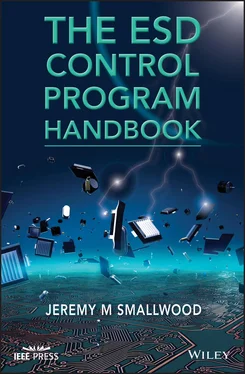1 ...7 8 9 11 12 13 ...24 Engineers often talk about the potential of (for example) a conductor (see Section 1.7.3for a discussion of conductors and insulators), as a synonym to voltage. This is not strictly correct as potential is strictly the work done in bringing a charge from infinity to the place of measurement (Jonassen 1998).
A voltage or potential difference at a place of measurement must always be referred to another place. In practice, the potential difference is usually quoted with reference to the potential of the earth (also referred to as ground ; see Section 1.5), which is defined for convenience as zero volts. If this other place is not specifically stated, it is usually ground (the earth).
All points in space surrounding a charge have a voltage (potential) – typically this voltage will be different from its neighboring points. For a conducting surface, if it is not initially an equipotential, voltage differences cause charge (current) to flow until the voltage around the surface is eventually equal. So, an electrically conducting surface in equilibrium is an equipotential surface.
1.2.5 Electric or Electrostatic Field
Any charge has a region of influence around it, in which various electrostatic effects are noticed – this region is the electric (electrostatic) field due to the charge. Charge is the fundamental source of static electricity, and the electrostatic field shows the effect of the charge in the world around the charge source. In this field, we find that
Like polarity charges are repelled.
Opposite polarity charges are attracted.
Conductors (e.g. metals) redistribute their charges and experience a change of potential (voltage) in response to the field.
Particles of many materials may be attracted or repelled within the field.
Static electricity phenomena are due to these basic effects.
Dust particles, and small objects, are attracted or repelled by a field, especially if they are themselves charged (e.g. ionized particles in the air). The force F experienced by a charge q in an electrostatic field E is (Cross 1987)

If equal positive and negative charge are sufficiently close together, from a distance their electric field effects cancel, and no external field is noticed. The charges are said to be neutralized .
Electrostatic fields and potentials around an object are not easy to visualize. One way of doing so is by use of field and equipotential lines. A field line represents the path a small charge would take, if it were free to move under the influence of the force due to the electrostatic field alone. Field lines always leave a conductor at a right angle (90°) to the surface.
In Figure 1.1a charged spherical conducting object has a potential V . Each point in the surrounding space can also be assigned a potential, according to the work required to move a unit charge to that position. If all the positions of equal potential are marked, an equipotential line (or in three dimensions a surface) is marked out. A system of equipotential surfaces could be marked, forming contours of potential showing the presence of the peak in potential rather like the contours on a map showing the presence of a hill. Equipotential lines are always at a right angle (90°) to the field lines.
Equipotential lines are like contour lines on a map of an area of the earth's surface. Height is a form of potential energy. If a ball is released on a smooth hillside, it will roll down the hill perpendicular to the contour lines. Similarly, if a same polarity charge (e.g. a positive charge, next to a high positive potential) is present in the electrostatic field, it will move away from the peak in potential, in a path perpendicular to the equipotential lines. These paths form lines of electrostatic field. The intensity of the field is given by how close together the field and equipotential lines are.

Figure 1.1Field lines and equipotential around a charged sphere.
The electric field E (vector, as it has magnitude and direction) is the gradient of voltage V over a distance s . Electric field, therefore, has the units volts per meter (V/m).

In Figure 1.1if the charged sphere is very small, it is effectively a point of charge. The electrostatic field around the charge Q at a distance r from this point is proportional to the charge present, according to Coulomb's law (Cross 1987)

From this equation, in this case the field strength decreases rapidly with the distance from the charge, with 1/ r 2. This is also indicated by the spreading of the field lines with distance from the charge. Field lines can be considered to begin and end on electrostatic charges, and so a high density of field lines at a surface implies a high charge density as well as high electrostatic field.
For other shapes of charge patterns, the equipotentials will not in general be spherical, and field lines will in general be curved rather than straight lines. Field lines are always perpendicular to the equipotentials and are always perpendicular to conducting surfaces as these are also equipotentials.
In Figure 1.1, eight field lines cut the equipotential line. Each of these lines in principle originates on a charge. So, the field lines cutting a surface is related to the net charge within it. Gauss's law generalizes this to state that the component of electric field perpendicular to a surface is proportional to the charge enclosed by the surface. For further information, the reader should refer to more academic texts such as Cross (1987).
1.2.7 Electrostatic Attraction (ESA)
A charge in an electrostatic field experiences a force, as described in Section 1.2.2. So, a charged particle or object will also experience a force according to the charge it carries. This causes charged particles and objects to be attracted or repelled by other objects, some of which may be product or items that are required to be kept clean. This effect is known as ESA.
A lesser known phenomenon that contributes to electrostatic attraction or repulsion is dielectrophoresis (Cross 1987). In this case, uncharged particles can be attracted or repulsed in a divergent or convergent electrostatic field due to differences in the permittivity of the particle and the material in which it is immersed.
Coulomb's law shows that the field due to a point charge is proportional to the charge and inversely proportional to the distance from it squared (Cross 1987).

Permittivity (dielectric constant), ɛ , was defined to give a convenient constant of proportionality in this relation.

For air, the permittivity is very close to the permittivity of free space ɛ 0(vacuum) ɛ = ɛ 0= 8.8 × 10 −12Cm −1. Other materials have different permittivity and affect field strengths correspondingly. In general, a dielectric material has a permittivity greater than air. This is conveniently expressed as a relative permittivity ɛ r, and the permittivity is given by
Читать дальше


















